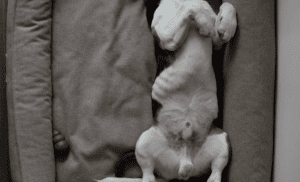Dogs with longer coats require regular grooming. This may include bathing and clipping or plucking, depending on the breed. In some breeds, the owners may choose to do this frequently, and in others, grooming maybe once every few months. It is not uncommon for dogs to show ear discomfort after grooming.
Dogs may shake their heads and scratch at their ears after grooming due to water that has entered the ear canal. Dogs may be allergic to shampoos which cause a reaction and infection in the ears. Plucking causes microtrauma in the membranes of the ears, which can lead to infection.
It is distressing for owners that look after their dogs diligently, attending to grooming needs, only to have the dogs succumb to ear infections.
Why Does My Dog keep Shaking His Ears After Grooming?
Grooming usually includes bathing the dog and then clipping it once dry. It is very easy for water to enter the dog’s ear canal during bathing. This is irritating and causes the dog to scratch its ears.
The moist environment created in the ears is perfect for fungal and bacterial growth leading to ear infections. The dog will shake his head when water is in the ears due to the strange, unfamiliar feeling. Scratching may also occur.
Another source of head-shaking after grooming is that the dog may be allergic to one of the grooming products used. This can result in a generalized allergy that causes inflammation in the skin.
Groomers often use more products on the ears if the dog has long-haired, floppy ears in an effort to comb out tangles and clean the ears thoroughly. The result is that the ears may be exposed to more of the allergenic product.
How To Soothe Dog’s Ears After Plucking?
Plucking ear hair from the inside of a dog’s ears is controversial. The concept is that the hair should be removed to air the ear and prevent wax and debris from being caught in the ear.
Dr. Heide Newton, a dermatology veterinary specialist, recommends that ear hairs are not plucked in dogs. Plucking is essentially ripping the hair, including the roots, out of the skin. This creates microtrauma to the skin, leaving it vulnerable to bacterial infection.
Many groomers state that ear hair plucking is not painful for the dog. If you try this at home, you will find that dogs are not happy with this procedure. They wiggle, squirm, try to get away, and may cry from pain.
Do not pluck your dog’s ears or allow a groomer to pluck them. There is no benefit, and it hurts your dog. A study done in 2017 showed that dogs with hairy ears were no more likely to get ear infections than those with minimal hair.
There is no way to soothe ears that have been plucked. Some groomers recommend ear cleaners, but these contain products that will burn the already traumatized skin. Oils and creams could lead to infection as they enter the microtears.
If you have vet-approved painkillers, you can give these to your dog at the appropriate dose. You can divert your dog’s attention by playing a game or giving him a chew toy or large meaty bone.
How Should I Groom My Dog’s Ears?
Dr Newton recommends trimming the hair on the inside of the ear flap short. If the dog has pendulous ears, the hair on the face where the ears hang should also be short. If there is hair in the ears, it is best to clip it short with scissors.
Preventing Ear Irritation When Grooming
It is essential to prevent the ears from becoming irritated from grooming. A small cotton wool ball should be inserted into each ear before bathing to prevent water from entering the ear. Some groomers like to put some petroleum jelly on the cotton wool to get a good seal.
Be careful to ensure that water is not poured into the ear canal as then even the cotton wool earplug will not keep it dry.
The choice of shampoo is critical when dealing with dogs with allergic conditions. Many owners will request a specific shampoo or bring their own. The shampoo should be hypoallergenic and soothing to the skin.
Use minimal shampoo amounts on the ears to lessen the irritation. Rinsing the shampoo off thoroughly is key to preventing ear irritation.
How To Stop My Dog Shaking His Head After Grooming?
If your dog’s ears have not been plucked and he is shaking his head after grooming, there is a strong likelihood of water in his ears. Your dog will experience dulled hearing and irritation, just as you would if water remains in your ears after swimming.
You can take a wad of cotton wool, wrap it around your finger and gently insert it into the dog’s ear canal to dry excess water. Do not be tempted to use earbuds as these can cause damage to the ear.
Dog ear cleaning products have ingredients that increase fluid evaporation from the ear. You can use these ear cleaning products to help clear water out of the ear.
There are dog ear ointments that contain cortisone, antibiotics, antifungals, and sometimes a local anaesthetic. These are usually used for dogs with ear infections and need to be prescribed by a veterinarian. If your dog is vulnerable to ear infections and you have this medicine on hand, you can use it to soothe your dog’s ears.
Some groomers recommend a sock-like hood that is pulled over the dog’s head to prevent him from shaking his head. Unfortunately, it does not stop the irritation, and some dogs will begin scraping their heads along walls or floors.
You can also distract your furry friend by playing games with him, going for a walk, or providing chew toys.
Complications of Ear Infections After Grooming
Grooming can cause ear infections that make the dog feel miserable and are challenging to resolve. Some complications can arise from ear infections.
Aural hematomas are alarming and unsightly. They occur when the dog shakes its head vigorously, bursting the capillaries in the ear flap. This internal bleeding results in a massively swollen ear flap or pinna.
Aural hematomas do not resolve by themselves and usually require surgery to be corrected. The veterinarian makes an incision and drains the blood. The blood vessels may be cauterized to prevent recurring bleeding. Stitches are usually placed around the blood pocket to stop further blood collection.
Persistent ear infections can lead to the dog experiencing hearing loss. The vestibular system, situated in the ear, can also be damaged, leading to a loss of balance.
There may also be damage to the facial nerve, which can have varied permanent consequences for the dog.
Conclusion
Ear infections can occur after grooming, but they can be prevented with proper care. It is vital to make every effort to protect the ears while grooming, as ear infections and head-shaking can have serious consequences.



